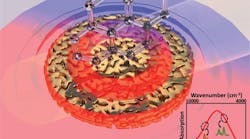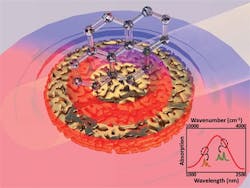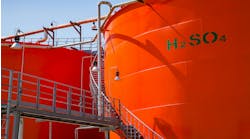A new technique can provide chemical and refractive information about compounds that can’t be measured accurately using infrared (IR) sensors, say researchers at the University of Houston (UH), Texas. Their method relies on near-infrared (NIR) light but gives far more detail than current NIR techniques, they add.
Figure 1. Surface-enhanced near-infrared absorption (SENIRA) spectroscopy has been demonstrated for high sensitivity chemical detection. Source: University of Houston.
The work could have a number of potential applications, including improving downhole drilling analysis in the oil and gas industry and broadening the spectrum of solar light that can be harvested and converted to electricity, explains Wei-Chuan Shih, associate professor of electrical and computer engineering at UH.
“Surface-enhanced near-infrared absorption (SENIRA), or in general, plasmon-enhanced molecular spectroscopy, can be useful in chemical typing and trace analysis with no or little sample preparation,” notes Shih. “From a scientific point of view, it’s quite a novel discovery to excite plasmonic resonance at near-infrared and make it work for us,” he adds.
[callToAction]
Spectroscopy using the IR spectrum doesn’t work with water samples because IR light is absorbed by water. NIR light is compatible with water, but typically doesn’t provide the needed detail.
The researchers’ technique simultaneously obtains chemical and refractive index sensing in 1–2.5-µm NIR wavelength range on nanoporous gold (NPG) disks that feature high-density plasmonic hot-spots of localized electric field enhancement.
“We showed water is not an issue, but we can also increase the sensitivity of what we want to measure by 10,000 times,” says Shih.
Using the nanoporous gold disks, the researchers “tuned” or designed the nanodisks to react when exposed to specific wavelengths, to create a sensing technique with the advantages of both IR and NIR scanning. An article in Nano Letters includes more details.
The team tested their development with various crude oil and other hydrocarbon samples. The new technique could simplify the downhole fluid analysis process because it requires a smaller sample for analysis, an obvious advantage in laboratory characterization, notes Shih.
Gold, says Shih, is quite robust against various acids, bases and solvents. “Surface-enhanced spectroscopy, such as surface-enhanced Raman scattering and fluorescence can be employed to analyze surface adsorbates. The surface contaminants can be removed by strong acids and solvents for surface rejuvenation,” he adds.
To implement the technique for online analysis of streams at refineries or process plants, the NPG nanoparticles can either be directly manufactured on the wall of a flow channel, or dispersed as free-flowing particles in the fluids.
Houston-based oil field services companies Schlumberger and Halliburton have contacted the researchers about cooperating on the development of the technique.
The discovery holds potential for both the lab and the field, notes Oliver C. Mullins, a scientific advisor at Schlumberger and the primary originator of downhole fluid analysis. “Optical spectroscopy has made significant contributions in the oil and gas industry beyond laboratory characterization,” he says. “In particular, in situ fluid analysis in oil wells based on vibrational overtones and electronic absorption in the visible and near-infrared wavelengths has become an industry standard in wireline well logging. SENIRA brings in an exciting prospect for potential better sensor technology in both field and laboratory settings.”
Although their study used hydrocarbon composition analysis as an example of how the technique could be deployed, Shih believes it can be applied to any molecular species.
In addition to further system development, Shih plans to implement the technique in flow channels and microfluidic channels, as well as expand the detection targets.



